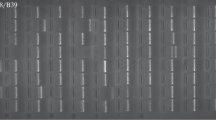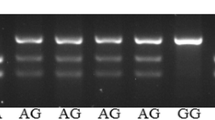Abstract
Breast cancer is considered a major malignancy among women worldwide. The contribution of genetic elements to the onset of familial breast cancer has already been established. The current study investigate the alfele frequency of HLA-DRB 1 in 36 primary operable female breast cancer patients from southern Iran by polymerase chain reaction using sequence specific primers (PCR-SSP). Results were compared with those of 36 female control subjects. Statistical analysis was performed and P values were determined for each character. Our results indicated that the frequency of HLA-DRB 1*12 allele is significantly higher in the patient group (p<0.03) compared to the control group. In addition, HLA-DRB1*11 appeared to be as the most frequent allele in the control group (29.2%) and had approximately the same distribution among the patient group (22.5%).
Similar content being viewed by others
References
Garfinkel I, Catherine C, Boring MPH, et al: An overview of breast cancer incidence and mortality. Cancer 74:222–227, 1994.
Szabo CI, King MC: Population genetics of BRCA1 and BRCA2. Am J Hum Genet 60:1013–1020, 1997.
Miki Y, Swense J, Shatuck-Eidens D, et al: A strong candidate for the breast and ovarian cancer susceptibility. Science 266:66–71, 1994.
Reiter DJ, Brocker EB, Ferrone S: Expression and susceptibility of modulation by interferones of HLA-class I and II antigens on melanoma cells. Immunohistochemical analysis and clinical relevance. J Immunogenetics 13:229–234, 1986.
Glew SS, Duggan-Keen M, Cabrera T, et al: HLA-class II antigen expression in human papilomavirus-associated cervical cancer. Cancer Res 52:4009–4016, 1992.
Paterson AC, Sciot R, Kew MC, et al: HLA expression in human hepatocellular carcinoma. Br J Cancer 57:369–373, 1988.
vanden Ingh HF, Ruiter DJ, Griffioen G, et al: HLA antigens in colorectal tumours-low expression of HLA class I antigens in mucinous colorectal carcinomas. Br J Cancer 55:125–130, 1987.
Tokumoto H: Analysis of HLA-DRB1-related alleles in Japanese patients with lung cancer-relationship to genetic susceptibility and resistance to lung cancer. J Cancer Res Clin Oncol 124:511–516, 1988.
Graham DE: The isolation of high molecular weight DNA from whole organisms or large tissue masses. Anal Biochem 85:609–613, 1978.
Miller SA, Dykes DD, Polesky IF: A simple sahing out procedure for extracting DNA from human nucleated cells. Nucl Acid Res 16:1215, 1988.
Olerup O, Zetterquist H: HLA-DR typing by PCR amplification with PCR-SSP in two hours. Tissue Antigens 39:225–235, 1992.
Casoli C, Zanelli P, Adorni A, et al: Serological and molecular study on the HLA phenotype of female breast cancer patients. Europ J Cancer 30A:1207–1208, 1994.
Pardon DM, Topalian SI: The role of CD4+ T cells responses in antitumor immunity. Curr Opin Immunol 10:588–589, 1998.
Armstrong ID, Elements VK, Ostrand-Rosenberg S: MHC class II-transfected tumor cells directly present antigen to tumor specific CD4+ T lymphocytes. J Immunol 160:660–666, 1998.
Armstrong TD, Elements VK, Ostrand-Rosenberg S: ClassIItransformed tumor cells directly present endogenous antigen to CD4+ T cells in vitro and are APCs for tumor-encoded antigen in vivo. J Immunother 21:218–224, 1998.
Feinmesser M, Sulkes A, Morgenstern S, et al: HLA-DR and beta 2 microglobulin expression in medullary and atypical medullary carcinoma of the breast: histopathologically similar but biologically distinct entities. J Clin Pathol 53:286–291, 2000.
Dadmarz R, Sgagias MK, Rosenberg SA, et al: CD4+ T lymphocytes infiltrating human breast cancer recognise autologous tumor in an MHC-class-II restricted fashion. Cancer Immunol Immunother 40:1–9, 1995.
Author information
Authors and Affiliations
Corresponding author
Rights and permissions
About this article
Cite this article
Ghaderi, A., Talei, A., Gharesi-Fard, B. et al. HLA-DRB 1 alleles and the susceptibility of Iranian patients with breast cancer. Pathol. Oncol. Res. 7, 39–41 (2001). https://doi.org/10.1007/BF03032603
Received:
Revised:
Accepted:
Issue Date:
DOI: https://doi.org/10.1007/BF03032603




